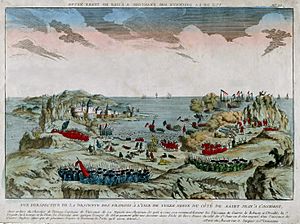Battle of Signal Hill facts for kids
Quick facts for kids Battle of Signal Hill |
|||||||
|---|---|---|---|---|---|---|---|
| Part of the Seven Years' War | |||||||
 Vue de la descente a Terre Neuve par le chevalier de Ternay en 1762, Unknown artist |
|||||||
|
|||||||
| Belligerents | |||||||
| Commanders and leaders | |||||||
| Strength | |||||||
| 1,559 | 800 | ||||||
| Casualties and losses | |||||||
| 24 killed and wounded | 40 killed and wounded | ||||||
The Battle of Signal Hill was fought on September 15, 1762, and was the last battle of the North American theatre of the Seven Years' War. A British force under Lieutenant Colonel William Amherst recaptured St. John's, which the French had seized earlier that year in a surprise attack.
Background
By 1762 France and Britain had been fighting for seven years, and both were now contemplating a peace agreement. Britain's long blockade of the French coast had forced the French economy into a decline and had prevented the French navy from going to the aid of France's colonies around the globe, which led to a large number being captured. To rebuild the French navy during the years of peace, the French believed that they needed access to the Newfoundland fishery and so an expedition was planned to take the island in anticipation of the coming peace negotiations. That occurred in May 1762 when a small force under the Chevalier de Ternay slipped out of Brest and past the blockade and headed out into the Atlantic.
French occupation
On June 27, 1762, the French under, Comte d'Haussonville, forced the British capitulation of St. John's. During the following weeks, d'Haussonville, under the orders of the Chevalier de Ternay, consolidated the French position in Newfoundland. His defence system consisted of several advance posts equipped with artillery around Signal Hill, a strategic point dominating the surrounding area.
On September 13, 1762, the British landed at Torbay, a few miles to the north. Ternay and Haussonville were unable to counter it and so to hamper the British advance, they dispatched a detachment to guard the bare summit of Signal Hill.
Regional importance
St. John's, being the most easterly city in the Americas, excluding those of Greenland, was an important place to dock ships from Europe and prepare them for further inland journeys. The French took the valuable land from the British, who responded with the same tactic and eventually won. Apart from its seaboard advantages, St. John's was highly regarded for its abundance in natural resources. St. John's had a huge fishing industry; by 1540, Spanish and Portuguese ships were travelling to the point solely to gather fish. The land is also abundant in fir and spruce trees, which were commonly used in ships and often as sources of food/medicine.
Signal Hill, on the other hand, was used as a centre for the defence of St. John’s throughout the 18th century. Being along the Atlantic coast, northeast of the Avalon Peninsula (southeastern Newfoundland), Signal Hill is positioned next tp the inlet of the harbour of St. John's. Since sea was the only effective mode of transportation during the battle, troops on Signal Hill could spot seaboard vehicles from far off. Additionally, Signal Hill had to be passed to enter the settlement of St. John’s via sea, which made it difficult for foreign warships to destroy the settlement.
Battle
On 26 August, British-Yankee warships dispatched by Amherst and under Captain Campbell had reached the now-British Halifax Harbour and hoped to recapture St. John's. Returning to sea on 1 September, three days after the expected date because of contrary winds, those particular men-of-war had reached Louisbourg on 5 September. After leaving on the 7th, Campbell's fleet joined that of Lord Colvill's on the 11th, not far from the southern coast of St. John's. Nearing the 12th, the fleets landed at Torbay, a few miles north of St. John's, and took three prisoners. The French commanders, Count D'Haussonville and Bellecombe, were unable to prevent the British landing at Torbay and so they sent a battalion to guard Signal Hill as an important protection summit for its natural defences. At the break of September 15, British troops climbed the hill held by the French. The surprise was total, and the engagement was brief but fatal. The commander of the French detachment, Guillaume de Bellecombe, was seriously wounded. On the British side, a bullet shattered the legs of one of Amherst's officers, MacDonell. The British attacked about 295 French infantry, which resulted with the remainder of the French (about 600) retreating to Fort William.
Aftermath
At the close of the battle, Signal Hill was in the hands of the British. Strengthened by their advantageous situation, the British had numerous artillery pieces delivered to their position from Torbay and began to construct batteries to bombard the fort. Three days later, they obtained the capitulation of the French garrison of St. John's, which consisted of just over 700 French regulars.
See also
 In Spanish: Batalla de Signal Hill para niños
In Spanish: Batalla de Signal Hill para niños

